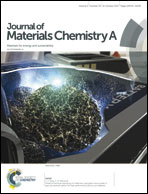Selective electroreduction of CO2 to formate on 3D [100] Pb dendrites with nanometer-sized needle-like tips†
Abstract
Honeycomb porous Pb films with a dendrite-like secondary structure growing along the [100]-axis were prepared by Dynamic Hydrogen Bubble Templating (DHBT) and used for the electroreduction of CO2. Detailed physicochemical characterization of the porous films revealed that the thickness (up to 70 μm) and electrochemically active surface area (up to 1500 cm2) of the porous Pb films could be tuned through the current density (varied between −1 and −4 A cm−2) and deposition time (varied between 3 and 60 s). The electrochemical activity and stability of the electrodes toward the electroreduction of CO2 were investigated by linear sweep voltammetry and potentiostatic electrolysis in 1 M KHCO3 electrolyte at standard pressure and room temperature. The formate production was quantified by UV-visible spectrophotometry. The faradaic efficiency for formate was larger than 90% for electrodes with electrochemical surface areas above 500 cm2 and it was attributed to an increased fraction of the [100] surfaces. The porous Pb film deposited at −4.0 A cm−2 and 40 seconds proved to be a highly active and stable electrode, with a partial current density (jformate) of −7.5 mA cm−2 and a faradaic efficiency of 97% for formate at an overpotential of −0.99 V after 6 hours of electrolysis.
![Graphical abstract: Selective electroreduction of CO2 to formate on 3D [100] Pb dendrites with nanometer-sized needle-like tips](/en/Image/Get?imageInfo.ImageType=GA&imageInfo.ImageIdentifier.ManuscriptID=C7TA06528K&imageInfo.ImageIdentifier.Year=2017)
- This article is part of the themed collection: 2017 Journal of Materials Chemistry A HOT Papers


 Please wait while we load your content...
Please wait while we load your content...